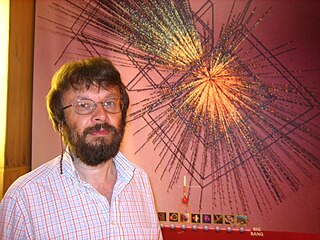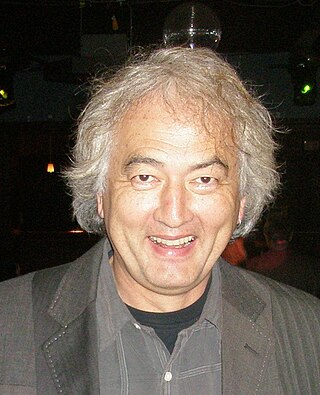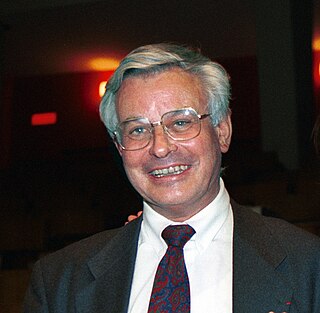
A gluon is an elementary particle that acts as the exchange particle for the strong force between quarks. It is analogous to the exchange of photons in the electromagnetic force between two charged particles. Gluons bind quarks together, forming hadrons such as protons and neutrons.

In physics and chemistry, a nucleon is either a proton or a neutron, considered in its role as a component of an atomic nucleus. The number of nucleons in a nucleus defines the atom's mass number.

The Relativistic Heavy Ion Collider is the first and one of only two operating heavy-ion colliders, and the only spin-polarized proton collider ever built. Located at Brookhaven National Laboratory (BNL) in Upton, New York, and used by an international team of researchers, it is the only operating particle collider in the US. By using RHIC to collide ions traveling at relativistic speeds, physicists study the primordial form of matter that existed in the universe shortly after the Big Bang. By colliding spin-polarized protons, the spin structure of the proton is explored.

High-energy nuclear physics studies the behavior of nuclear matter in energy regimes typical of high-energy physics. The primary focus of this field is the study of heavy-ion collisions, as compared to lighter atoms in other particle accelerators. At sufficient collision energies, these types of collisions are theorized to produce the quark–gluon plasma. In peripheral nuclear collisions at high energies one expects to obtain information on the electromagnetic production of leptons and mesons that are not accessible in electron–positron colliders due to their much smaller luminosities.
Hadronization is the process of the formation of hadrons out of quarks and gluons. There are two main branches of hadronization: quark-gluon plasma (QGP) transformation and colour string decay into hadrons. The transformation of quark-gluon plasma into hadrons is studied in lattice QCD numerical simulations, which are explored in relativistic heavy-ion experiments. Quark-gluon plasma hadronization occurred shortly after the Big Bang when the quark–gluon plasma cooled down to the Hagedorn temperature when free quarks and gluons cannot exist. In string breaking new hadrons are forming out of quarks, antiquarks and sometimes gluons, spontaneously created from the vacuum.
This is a timeline of subatomic particle discoveries, including all particles thus far discovered which appear to be elementary given the best available evidence. It also includes the discovery of composite particles and antiparticles that were of particular historical importance.

Quark–gluon plasma is an interacting localized assembly of quarks and gluons at thermal and chemical (abundance) equilibrium. The word plasma signals that free color charges are allowed. In a 1987 summary, Léon van Hove pointed out the equivalence of the three terms: quark gluon plasma, quark matter and a new state of matter. Since the temperature is above the Hagedorn temperature—and thus above the scale of light u,d-quark mass—the pressure exhibits the relativistic Stefan-Boltzmann format governed by temperature to the fourth power and many practically massless quark and gluon constituents. It can be said that QGP emerges to be the new phase of strongly interacting matter which manifests its physical properties in terms of nearly free dynamics of practically massless gluons and quarks. Both quarks and gluons must be present in conditions near chemical (yield) equilibrium with their colour charge open for a new state of matter to be referred to as QGP.

Marek Gaździcki is a Polish high-energy nuclear physicist, and the initiator and spokesperson of the NA61/SHINE experiment at the CERN Super Proton Synchrotron (SPS).
Hot spots in subatomic physics are regions of high energy density or temperature in hadronic or nuclear matter.

The onset of deconfinement refers to the beginning of the creation of deconfined states of strongly interacting matter produced in nucleus-nucleus collisions with increasing collision energy.

Johann Rafelski is a German-American theoretical physicist. He is a professor of Physics at The University of Arizona in Tucson, guest scientist at CERN (Geneva), and has been LMU-Excellent Guest Professor at the Ludwig Maximilian University of Munich in Munich, Germany.
In high-energy nuclear physics, strangeness production in relativistic heavy-ion collisions is a signature and diagnostic tool of quark–gluon plasma (QGP) formation and properties. Unlike up and down quarks, from which everyday matter is made, heavier quark flavors such as strange and charm typically approach chemical equilibrium in a dynamic evolution process. QGP is an interacting localized assembly of quarks and gluons at thermal (kinetic) and not necessarily chemical (abundance) equilibrium. The word plasma signals that color charged particles are able to move in the volume occupied by the plasma. The abundance of strange quarks is formed in pair-production processes in collisions between constituents of the plasma, creating the chemical abundance equilibrium. The dominant mechanism of production involves gluons only present when matter has become a quark–gluon plasma. When quark–gluon plasma disassembles into hadrons in a breakup process, the high availability of strange antiquarks helps to produce antimatter containing multiple strange quarks, which is otherwise rarely made. Similar considerations are at present made for the heavier charm flavor, which is made at the beginning of the collision process in the first interactions and is only abundant in the high-energy environments of CERN's Large Hadron Collider.
The EMC effect is the surprising observation that the cross section for deep inelastic scattering from an atomic nucleus is different from that of the same number of free protons and neutrons. From this observation, it can be inferred that the quark momentum distributions in nucleons bound inside nuclei are different from those of free nucleons. This effect was first observed in 1983 at CERN by the European Muon Collaboration, hence the name "EMC effect". It was unexpected, since the average binding energy of protons and neutrons inside nuclei is insignificant when compared to the energy transferred in deep inelastic scattering reactions that probe quark distributions. While over 1000 scientific papers have been written on the topic and numerous hypotheses have been proposed, no definitive explanation for the cause of the effect has been confirmed. Determining the origin of the EMC effect is one of the major unsolved problems in the field of nuclear physics.

Fermilab E-906/SeaQuest is a particle physics experiment which will use Drell–Yan process to measure the contributions of antiquarks to the structure of the proton or neutron and how this structure is modified when the proton or neutron is included within an atomic nucleus.

The NA49 experiment was a particle physics experiment that investigated the properties of quark–gluon plasma. It took place in the North Area of the Super Proton Synchrotron at CERN from 1991-2002. It used a large-acceptance hadron detector to investigate reactions induced by the collision of various heavy ions on targets made of a variety of elements.

John William Harris is an American experimental high energy nuclear physicist and D. Allan Bromley Professor of Physics at Yale University. His research interests are focused on understanding high energy density QCD and the quark–gluon plasma created in relativistic collisions of heavy ions. Dr. Harris collaborated on the original proposal to initiate a high energy heavy ion program at Cern in Geneva, Switzerland, has been actively involved in the CERN heavy ion program and was the founding spokesperson for the STAR collaboration at RHIC at Brookhaven National Laboratory in the U.S.
The proton spin crisis is a theoretical crisis precipitated by a 1987 experiment by the European Muon Collaboration (EMC), which tried to determine the distribution of spin within the proton.

Maurice René Michel Jacob was a French theoretical particle physicist.

Emanuele Quercigh is an Italian particle physicist who works since 1964 at CERN, most known for the discovery of quark-gluon plasma (QGP). Quercigh moved as a child to Friuli with his mother and his younger brother after the early death of his father. Quercigh studied physics at the University of Milan in Italy, where he became assistant of professor Giuseppe Occhialini in 1959.
Reinhard Stock is a German experimental physicist, specializing in heavy-ion physics.













